George W. Stimson introduction to Airborne Radar (Se)
Подождите немного. Документ загружается.

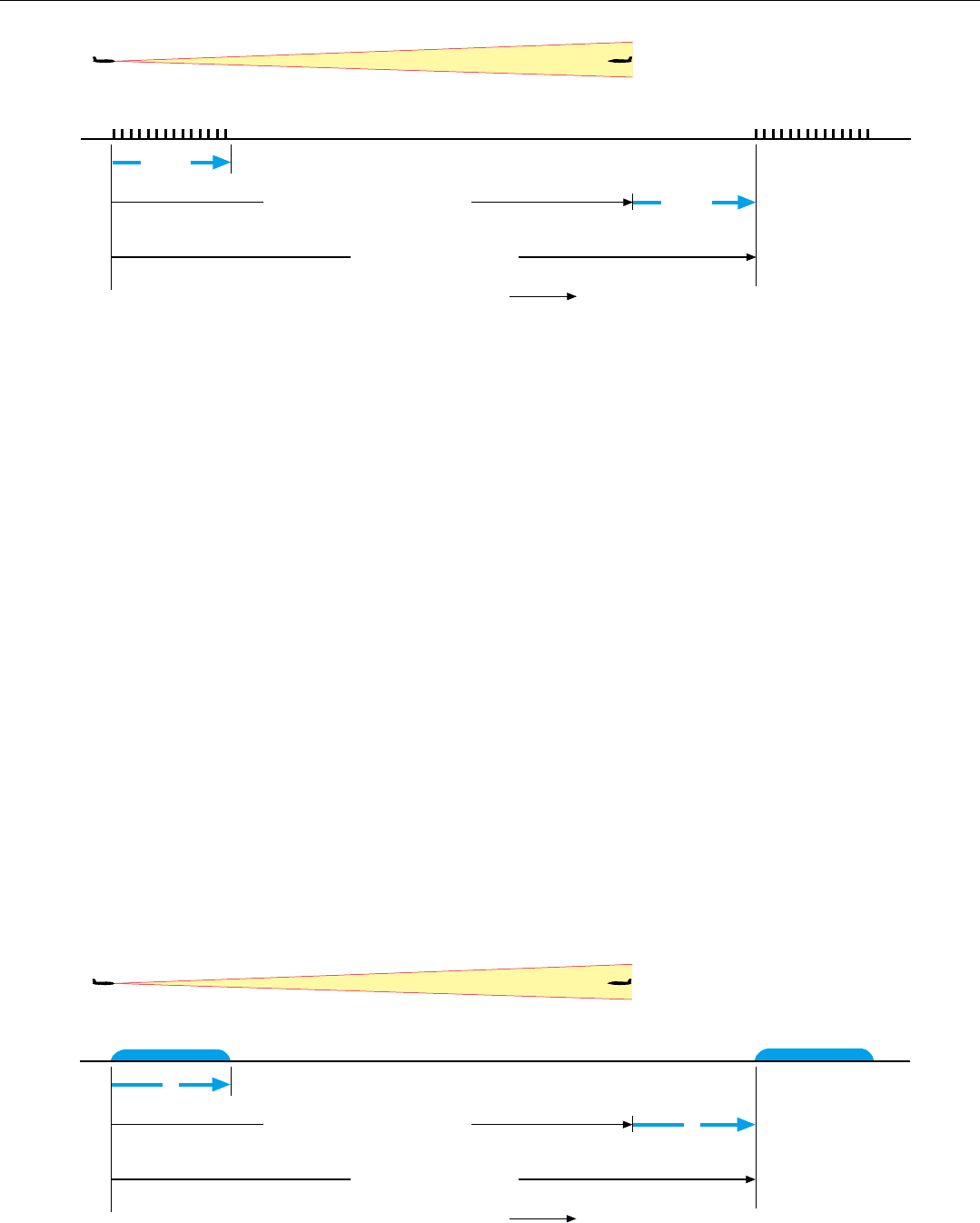
CHAPTER 41 Advanced Waveforms and Mode Control
521
targets. As illustrated in Fig. 3, if the repetition period of
the bursts is made equal to the round-trip ranging time for
the maximum range of interest plus the burst length, τ
burst
,
range ambiguities will be avoided. Moreover, returns from
targets at ranges greater than half the burst length (0.5
cτ
burst
) will not be eclipsed by any of the transmitted pulses
and will not be received simultaneously with any sidelobe
return from shorter ranges.
Returns from targets at ranges less than half the burst
length will, of course, be partially eclipsed and will be
received with some sidelobe clutter from shorter ranges.
But, because of the targets’ short range, the loss of detection
sensitivity is not particularly severe and becomes less and
less so as the range decreases.
Monopulse Doppler
This waveform is essentially a low-PRF equivalent of
pulse burst, in that a single long pulse is substituted for
each pulse burst (Fig. 4). As a result, for the same peak
power the average power is increased substantially.
3. Pulse burst waveform. If the burst repetition period is made equal to the ranging time for the maximum range of interest plus the burst width,
τ
burst
, range ambiguities will be avoided. The burst width is added to keep the echoes of targets at maximum range from being eclipsed by
the next burst of pulses.
4. Monopulse doppler is essentially the same as pulse burst except that, instead of bursts of high-PRF pulses, single, long pulses are transmitted
and the received signals are sampled at a high repetition rate.
Transmitted Pulses
Ranging Time for
Maximum Range of Interest
Interpulse Period, T
Time
τ
burst
τ
burst
Ranging Time for
Maximum Range of Interest
Interpulse Period, T
Time
τ
τ
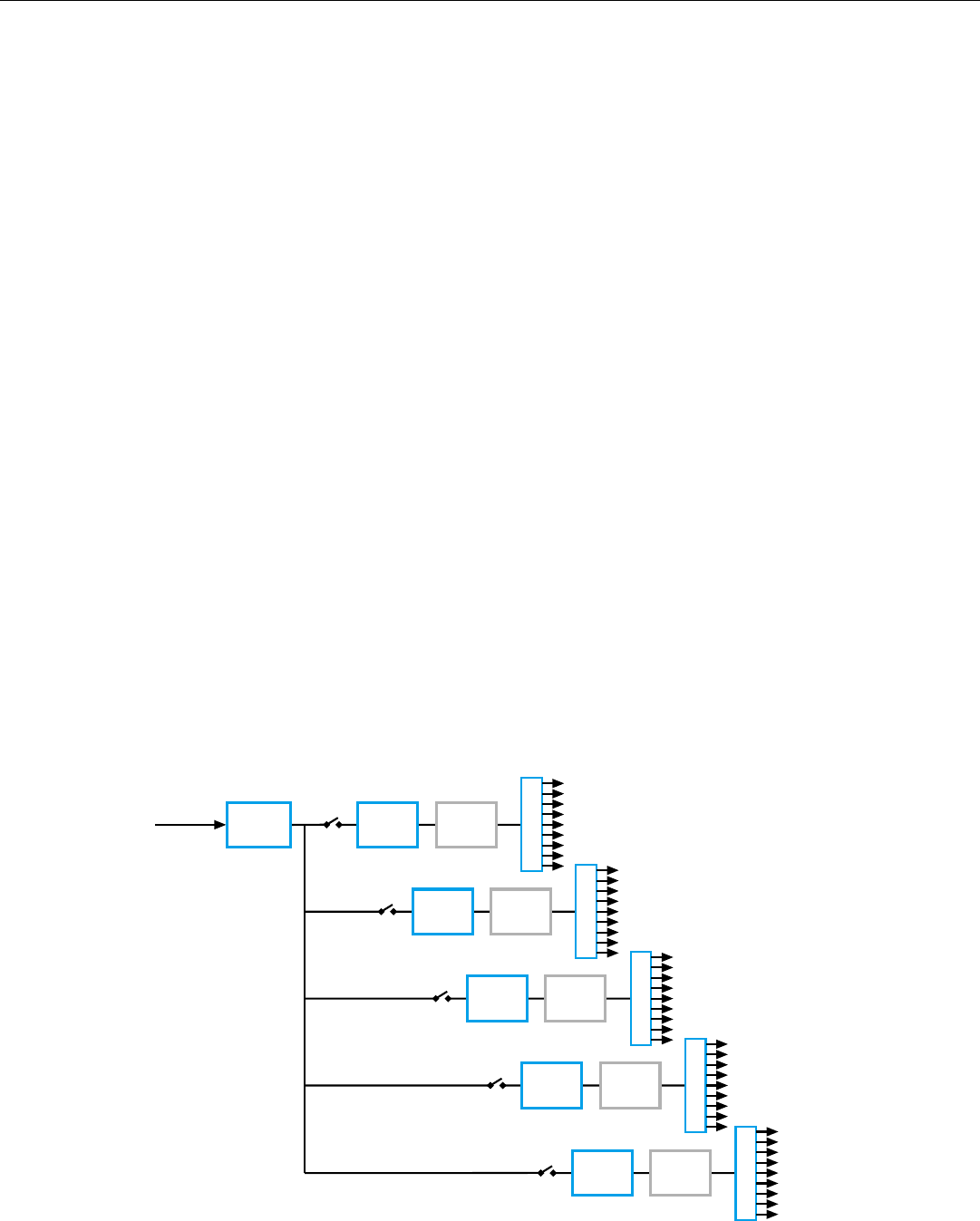
PART IX Advanced Concepts
522
For example, if the duty factor within the bursts were 40
percent, other factors being equal, monopulse doppler
would provide two and a half times the average power of
pulse burst.
Problems of doppler blind zones and returns from
ground moving targets—which limit the effectiveness of
conventional low-PRFs are avoided by sampling the radar
return at a high enough rate to provide an adequately wide
doppler-clear region between repetitions of the mainlobe
clutter spectrum. Because of this and of range being unam-
biguous, coarse range as well as doppler resolution, may be
obtained following the transmission of every pulse—hence
the name, monopulse doppler. Finer range resolution may,
of course, be obtained by employing pulse compression.
In one possible implementation, the samples of the radar
return are fed in parallel to a set of range gates (Fig. 5,
below). The opening of successive gates is staggered in time
by an amount equal to the pulse width (compressed pulse
width, if pulse compression is used). Each gate is left open
for a time equal to the pulse width.
The samples passing through each gate are collected in
range bins and coherently integrated to form a doppler fil-
ter bank for each range increment. Since the integration
time of the doppler filters is limited to the duration of the
transmitted pulse, the doppler resolution is fairly coarse.
If desired, finer doppler resolution can be obtained by
forming a second bank of doppler filters with the outputs
each coarse filter produces for several transmitted pulses.
5. One possible implementation of monopulse doppler. Opening of successive gates—closing of the switches shown here—is staggered by the
pulse width (compressed pulse width, if pulse compression is used). Gates are left open for a time equal to the pulse width.
A/D
Conv.
Range
Bin
Pulse
Comp.
Gate
Return
From a
Single
Pulse
Filter Bank
Range
Bin
Pulse
Comp.
Gate
Filter Bank
Range
Bin
Pulse
Comp.
Gate
Filter Bank
Range
Bin
Pulse
Comp.
Gate
Filter Bank
Range
Bin
Pulse
Comp.
Gate
Filter Bank
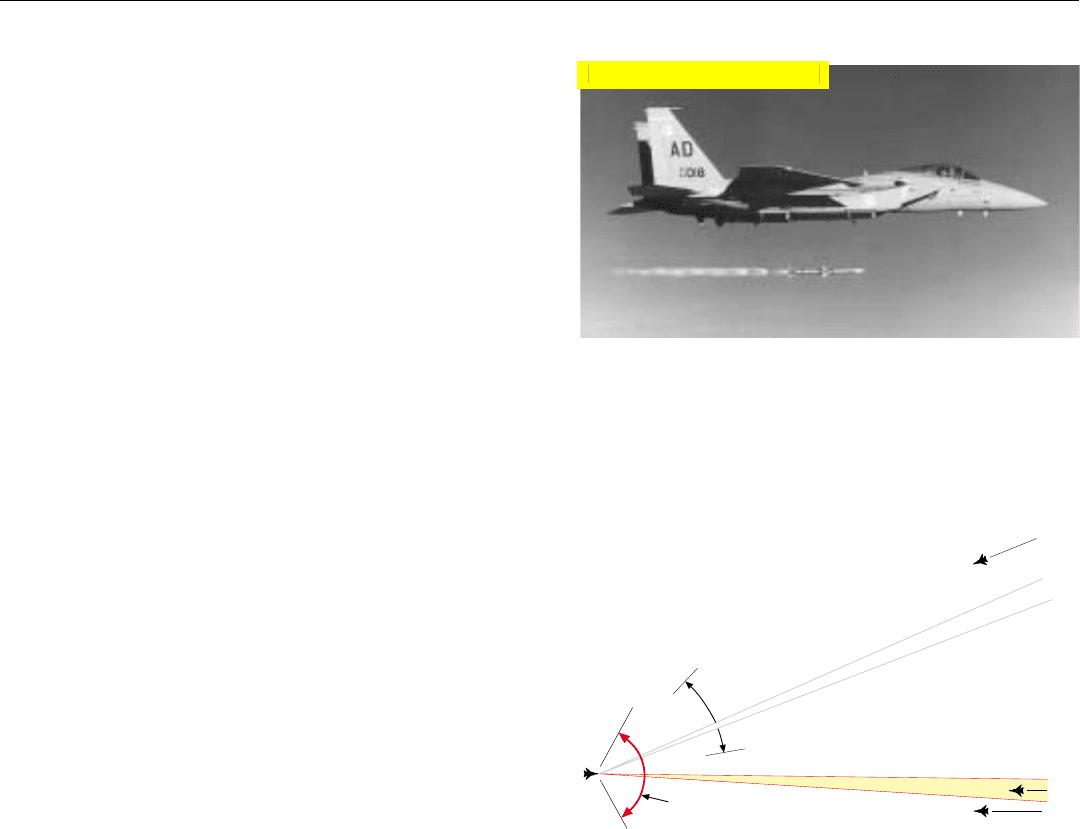
CHAPTER 41 Advanced Waveforms and Mode Control
523
Search-While-Track (SWT) Mode
A fighter’s radar has three basic reasons to track more
than one target simultaneously: (a) to individually monitor
potentially threatening targets, (b) to provide periodic tar-
get illumination for semiactive guidance of missiles not
requiring continuous illumination (e.g., Phoenix), and (c)
to provide periodic target position updates for missiles
employing command-inertial guidance (e.g., AMRAAM). At
the same time, the radar may be required to search one or
more narrow sectors for targets designated by offboard or
other onboard sensors (e.g., IR search/track set) and to pro-
vide continuous situation awareness in a given sector.
While these requirements can be satisfied by the conven-
tional track-while-scan mode,
2
it has a number of serious
shortcomings. Not all of the targets must be tracked with
the same revisit rates or the same dwell times. They may
not all lie in the same sector or in the sector where desig-
nated targets must be searched for or where situation
awareness is desired.
These limitations can all be surmounted by taking
advantage of the extreme beam agility of the ESA (Fig. 7).
Rather than refreshing target tracks each time the radar’s
beam sweeps over them in a continuous search scan, the
beam of an ESA can jump almost instantaneously to any
target as often and for as long a dwell as necessary to accu-
rately track it. The beam can then jump back to whatever
sector it was searching without appreciably increasing the
scan frame time. While tracking targets in this way, the
beam can simultaneously search specific narrow sectors for
designated targets and provide situation awareness with
selectable frame times in other sectors, or none at all.
To avoid confusion with conventional track-while-scan,
this versatile new mode is called search-while-track (SWT).
Mode Management
So far in this and earlier chapters, we’ve considered the
various radar waveforms, modes, and techniques individu-
ally. But to carry out such functions as mode interleaving,
adaptive dwell scheduling, multiple waveform utilization,
and sensor fusion, the radar’s front-end and processing
resources must be successively allocated at the correct
instants in time to each required internal operation.
A highly flexible and efficient answer to this requirement
is a two-level mode-management software architecture out-
lined below.
In this architecture, the first level of management is per-
formed by the avionic system’s Sensor Manager. It receives
requests for various radar operations from the flight crew’s
controls and other key subsystems and converts them into
7. In search-while-track (SWT), a radar can search for targets
while tracking targets anywhere within the field of regard,
without materially increasing the scan frame time. Both track
update intervals and dwell times are adaptively selected.
2. Described in detail on pages
388–390.
Region being
searched
Targets
Being
Adaptively
Tracked
Field of
Regard
6. One of several potential needs for SWT is to provide target
position updates for AMRAAMs which may be in flight
against widely separated targets outside the current search-
scan sector.
Click for high-quality image

PART IX Advanced Concepts
524
prioritized commands in coarse time—on the order of sec-
onds. Some representative commands are listed in Fig. 8.
The second level of management is performed by the
Radar Manager. Upon receipt of the Sensor Manager’s com-
mands, it adjusts the coarse time line to account for the
radar’s current state of operation and system constraints.
3
It
then allocates the radar’s front-end and processing
resources to the requisite tasks in fine time intervals—on
the order of nanoseconds. Allocations typically include:
• Field of regard
• Length of individual dwells
• Waveform for each dwell
• Front-end hardware to transmit the waveform
•
Processing resources to extract the required informa-
tion from the collected data and report it to the Sensor
Manager and the air crew or requesting avionics system
Thus, through simple prioritized radar-operation
requests, the radar’s resources are flexibly allocated so as to
both avoid conflicts and assure prompt response to high
priority requirements in complex tactical situations.
Summary
To increase detection sensitivity against tail-aspect tar-
gets, several advanced waveforms have been developed.
Range-gated high PRF resolves closely spaced targets and
improves performance against low-closing-rate targets by
employing pulse compression and a limited number of nar-
row range bins.
Pulse burst transmits high-PRF pulses in short bursts, to
enable clutter-free detection of nose-aspect targets, and
repeats the bursts at a low rate to simultaneously gain the
advantage of low PRFs in avoiding sidelobe clutter.
Monopulse doppler accomplishes the same ends but
provides higher average power by replacing the bursts with
long pulses, and by sampling the returns at a high rate.
By taking full advantage of the ESA’s extreme beam agili-
ty, a new search-while-track mode simultaneously tracks
widely separated targets with interactively selected dwell
times and revisit rates, searches narrow regions for desig-
nated targets, and selectively provides situation awareness.
By allocating the radar’s front-end and processing
resources to successive operations through prioritized
requests, an advanced mode-selection software architecture
enables the radar to flexibly and efficiently carry out such
complex functions as mode interleaving, adaptive dwell
scheduling, and multiple waveform utilization.
8. Sample prioritized sensor-level commands for basic radar
functions in coarse time—order of seconds.
• Perform search-while-track (SWT) in a volume
centered at N, E, D of size ρ, ϕ, γ, with no LPI
constraints and with a priority of 10.
Report any detections and track files found in this volume.
Complete eight 2-second frames.
• Perform an own-ship precision velocity update
(PVU) with priority 20.
• Perform a long-range cued search about point
xyz immediately, with LPI protocol #6.
3. One such constraint is that
formation of a SAR map can-
not be interrupted.

525
Low Probability
of Intercept (LPI)
L
ow probability of intercept (LPI) is the term used for
there being a low probability that a radar’s emis-
sions will be usefully detected by an intercept
receiver in another aircraft or on the ground.
For the air battle of the future, LPI is essential. In con-
ventional aircraft the most important need for LPI is to
avoid electronic countermeasures. In low observable air-
craft, LPI additionally enhances the element of surprise and
denies the enemy use of radar intercept queuing of its fight-
ers. In aircraft of both types, LPI prevents successful attacks
by antiradiation missiles.
In this chapter, we will review the generic types of inter-
cept receivers and see what strategies may be used to defeat
them. We’ll then take up specific design features which may
be incorporated in a radar to ensure a low probability of
intercept. Finally, we’ll very briefly assess the cost of LPI
and consider possible future trends in LPI design.
Generic Intercept Systems
A combat aircraft may encounter any or all of four gener-
ic types of intercept receiving systems:
• Radar warning receivers (RWR)
• Intercept receiver sections of electronic countermea-
sures (ECM) systems
• Ground-based passive detection and tracking systems
• Antiradiation missiles (ARM)
The general capabilities of these systems are summarized in
Table 1 and briefly outlined below.
System
Detects
Role
Main-
lobe
Airborne
Ground-
based
Missile
RWR
ECM
Rcvr.
DOA
&
EL
ARM
• Warn air crew of potential attack
• Cue evasive maneuvers & ECM.
• Jammer turn-on, set-on, & pointing
• Support sophisticated deception ECM.
• Detect & locate intruding aircraft.
• Cue attack or enable avoidance.
• Home on emissions.
• Guide missile to emitter.
X
X
X
X
TABLE 1. Generic Intercept Systems
X
Side-
lobe
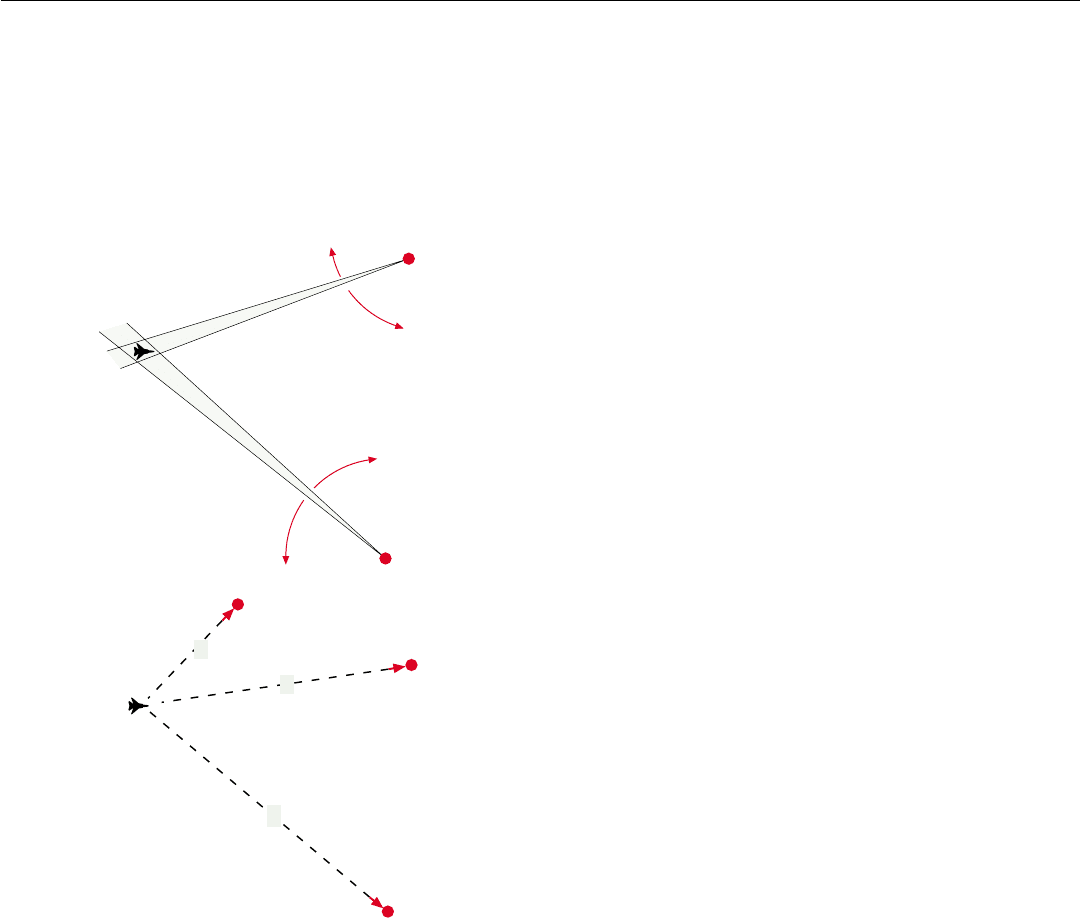
PART IX Advanced Concepts
526
1. Generic ground-based passive intercept systems. Both primar-
ily sense sidelobe emissions.
RWR. By sensing the mainlobe emissions from a radar in
a potentially hostile aircraft, the RWR warns the air crew of
imminent attack, enabling the pilot to maneuver evasively
and to employ defensive countermeasures.
ECM System Receivers. Operating primarily in the ra-
dar’s sidelobe regions, the intercept receiving portion of an
airborne or ground-based ECM system provides the cueing
necessary to concentrate jamming power at the radar’s fre-
quency and in the radar’s direction, as well as to employ
sophisticated deception countermeasures.
Ground-Based Systems. Intended to cue defending
forces to the approach of intruding aircraft, these systems
employ intercept receivers located at widely separated sites.
With narrowbeam scanning antennas, the receivers simulta-
neously detect and track the sidelobe emissions from an air-
craft’s radar to determine its position. The systems (Fig. 1)
are of two basic types. One, the direction-of-arrival system
(DOA), measures the direction of the source of the detected
pulses and determines its location by triangulation. The
other, the emitter locator (EL), determines the emitter’s loca-
tion by measuring the time of arrival of its pulses.
Against low-observable aircraft, DOA systems may be
used to provide lines of position to the aircraft. EL systems
may then determine their actual positions, enabling fighters
or ARMs to intercept them.
ARM. By detecting the sidelobe emissions of an aircraft’s
radar, the ARM homes in on the aircraft despite its evasive
maneuvers, hence is a serious threat to any aircraft employ-
ing a radar.
All four of these passive “threats” may be defeated
through a combination of (1) operational strategies of the
air crew of the radar-bearing aircraft and (2) strategies of
the radar designer.
Operational Strategies
The most effective LPI strategy of course is not to radiate
at all. This strategy may be approached by limiting radar
“on” time and operating with no higher power than
absolutely necessary to achieve mission goals.
On stealthy interdiction missions, wherever possible the
air crew should use collateral intelligence and reconnais-
sance information. Through careful mission planning they
may be able to conduct an entire mission with only a few
minutes—or even seconds—of radar operation.
In air-to-air combat situations, where continuous situa-
tion awareness is essential, the air crew should use onboard
passive sensors—RWR or ESM system, IR search-track set,
DOA SYSTEM
EL SYSTEM
t
1
t
2
t
3
Emitter
Emitter
Direction of arrival system
(DOA) measures the
direction of emitter from
two or more sites
Emitter locator (EL) com-
pares times of arrival of
emissions at multiple sites
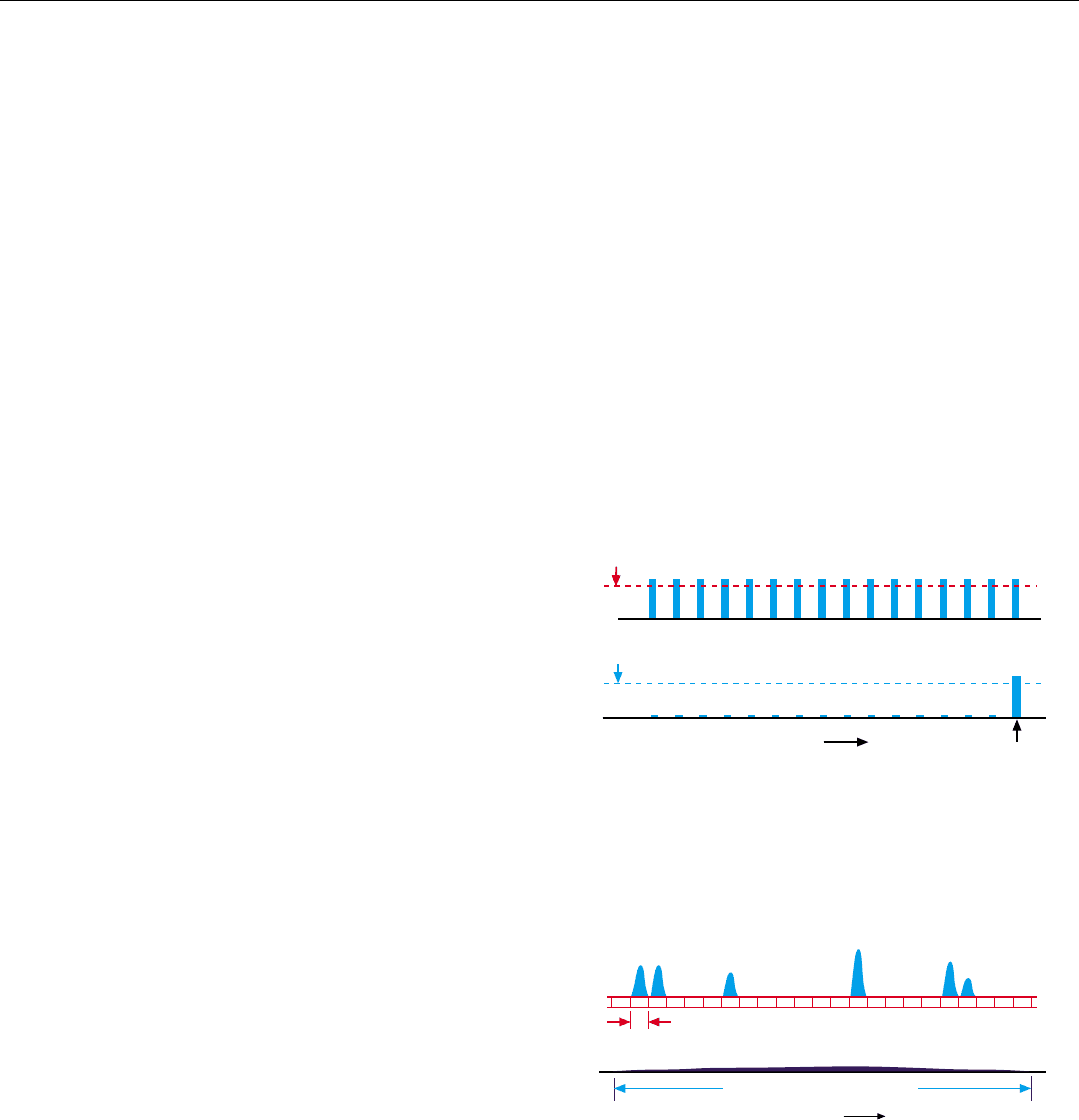
CHAPTER 42 Low Probability of Intercept (LPI)
527
or forward-looking IR set. When a potentially hostile air-
craft is detected, the radar may be used to measure range
and possibly precise angle, which the passive sensors may
not have provided. But it should be operated only in short
bursts and then only to search the narrow sector in which
the passive sensors indicate the target to be.
Design Strategies
Since the range at which a radar can detect a given target
varies as the one-fourth power of the emitted signal power,
whereas the range at which an intercept receiver can detect
the radar varies only as the square root of the emitted
power, the interceptor has a huge advantage over the radar.
However, since signals from a multitude of other radars and
electronic systems are inevitably present in a tactical envi-
ronment, the radar designer has several opportunities to
overcome this advantage.
Trade Integration for Reduced Peak Power. For a signal
to be usefully detected by an intercept receiver, its source
must be identified on the basis of such parameters as angle
of arrival, radio frequency, PRF (obtained from times of
arrival), and pulse width. To satisfy this requirement, the
intercept receiver must detect individual pulses.
Consequently, it can employ little or no signal integration;
it is sensitive primarily to peak emitted power. The radar,
on the other hand, is subject to no such requirement. By
coherently integrating the echoes it receives over long peri-
ods, the peak power needed to detect a target can be greatly
reduced, thereby reducing the detectability of the radar’s
signals (Fig. 2).
Trade Bandwidth for Reduced Peak Power. An intercept
receiver must be able to separate overlapping signals which
may be closely spaced in frequency. Consequently, the
instantaneous bandwidth of each of its channels can be no
wider than necessary to pass the narrowest pulses it can
reasonably be expected to receive and measure their time
and angle of arrival (Fig. 3). The radar, on the other hand,
can be designed to spread its power over a much wider
instantaneous-frequency band, thereby reducing the peak
power the intercept receiver receives through any one of its
channels by the ratio of the two bandwidths.
Trade Antenna Gain for Peak Power. Against an RWR,
the radar has the advantage of being able to employ a large
directional antenna, which the RWR cannot. During trans-
mission, of course, the high gain of this antenna benefits
the RWR as much as it benefits the radar. But during recep-
tion, the antenna’s large intercept area enables the same
2. Because an intercept receiver must detect individual pulses, it
is sensitive only to peak power. Because a radar can coher-
ently integrate the returns it receives, it is sensitive to average
power. Consequently, for LPI coherent integration time can
be traded for reduced peak power.
Radar
Intercept Receiver
Detection
Threshold
Detection
Threshold
Integrated
Returns
Time
3. Because an intercept receiver must separate pulses closely
spaced in frequency, its channels must be comparatively nar-
row. But a radar’s bandwidth is limited only by its design.
Consequently, for LPI, bandwidth can be traded for reduced
peak power.
Radar
Intercept Receiver
Channel Width
Instantaneous Bandwidth
Frequency

PART IX Advanced Concepts
528
detection sensitivity to be obtained with much lower peak
power.
Against those intercept receivers which depend on sens-
ing the radar antenna’s sidelobe emissions—ECM system’s
receiver, ground-based DOA and EL systems, and ARMs—
besides having a high gain and large intercept area, the
radar antenna has the advantage of a very large difference
between mainlobe and sidelobe gains. All of these charac-
teristics can be traded for reduced peak power. While
antenna size is generally limited by the dimensions of the
aircraft, sidelobe reduction is not. For LPI, the peak side-
lobe gain should be down at least 55 dB, relative to the
peak mainlobe gain (Fig. 4).
Other Trades for Reduced Peak Power. Other features
normally included in a radar to increase detection range
that can correspondingly enable peak power to be reduced
without reducing range include:
• High duty factor
• Low receiver noise figure
• Low receive losses
Low transmit losses, it might be noted, are of no advan-
tage for LPI. For unless the radar is operating at maximum
range, the peak emitted power can be set to the desired
level for LPI regardless of these losses.
Special LPI-Enhancing Design Features
Special features which may be used to further enhance
LPI include power management, use of wide instantaneous
bandwidths, transmission of multiple antenna beams on
different frequencies, randomizing waveform parameters,
and mimicking the enemy’s waveforms. Of these, power
management is the most basic.
Power Management. The role of power management is
to reduce the radar’s peak radiated power to the absolute
minimum needed to detect targets of interest at the mini-
mum acceptable range, with minimum margin. As the radar’s
targets close to shorter range, the power management sys-
tem must correspondingly reduce the emitted power (see
panel, top of facing page).
The advantages of power management can best be appre-
ciated by considering a simple example. Suppose that to
detect a given target at a range of 80 miles, a certain radar
must emit a peak power of 5,000 watts. To detect that same
target at 5 miles, however, the radar would need to emit a
peak power of only 0.076 watts!
4. Since most intercept receivers must rely upon detecting the
radar’s sidelobe emissions, for LPI the peak sidelobe gain
should be down at least 55 dB.
Conditions: A certain radar can detect a given target at
range R = 80 nmi by emitting a peak power P = 5,000 W.
Question: How much power need the radar emit to de-
tect the same target at 5 nmi?
Solution: The required peak power varies as the fourth
power of the desired detection range. Therefore,
5,000 W
80 nmi
POWER MANAGEMENT, PROBLEM 1
P
2
= P
1
R
2
R
1
4
P
2
= 5,000
80
5
4
= 0.076 W
Radar Antenna
Radiation
Pattern
Angle Off Boresight
– 55 dB
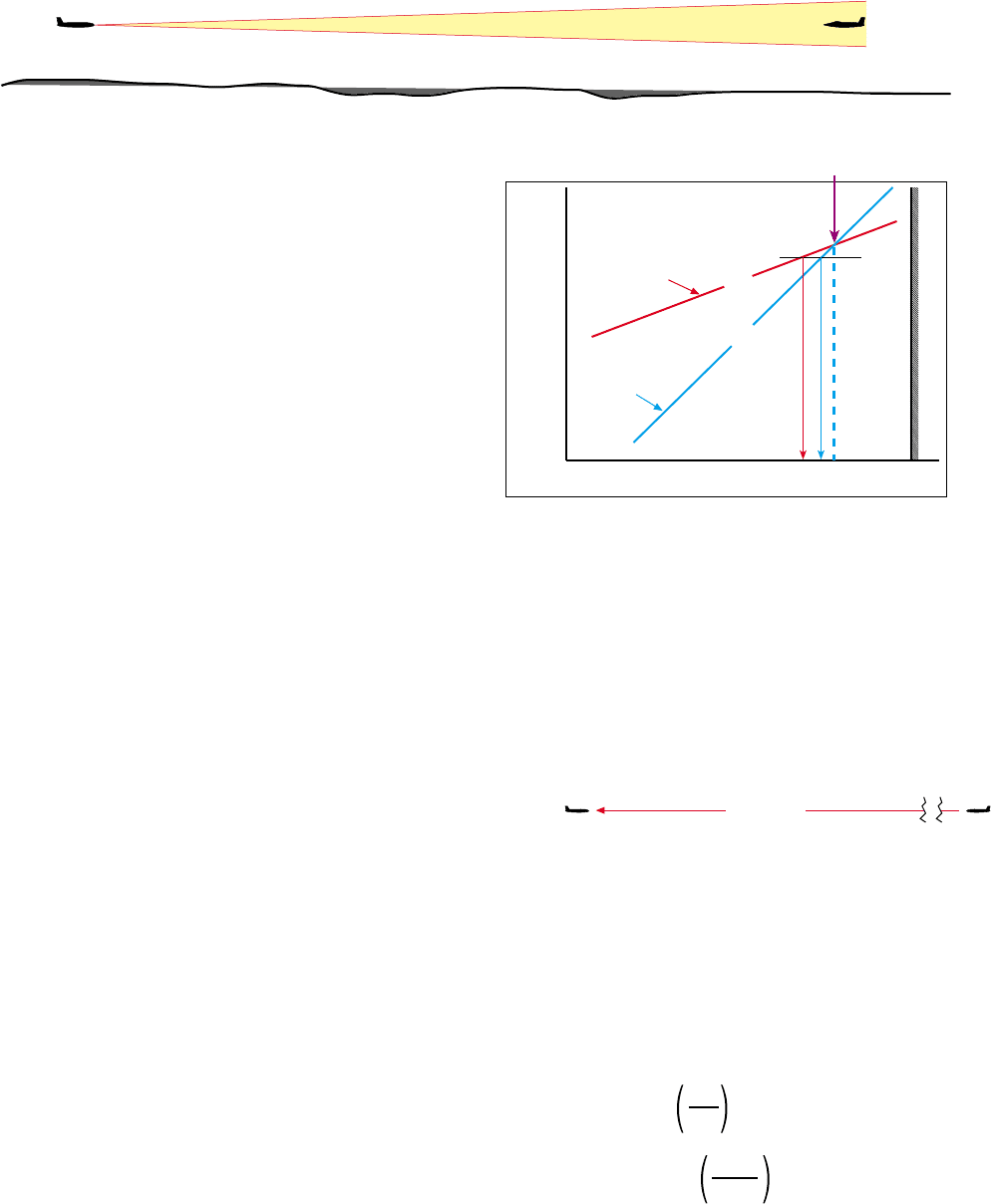
CHAPTER 42 Low Probability of Intercept (LPI)
529
Suppose now that, when the radar was emitting full
power, a given intercept system could detect it at 300 miles.
When the power was reduced to 0.076 watts, that same
intercept system could detect the radar at only 1.2 miles.
Clearly, power management is essential for LPI. Also
clear from the foregoing example: the power management
system must be able to reduce the emitted power in small,
precisely controlled steps over a very wide range—in this
hypothetical example, nearly 50 dB.
One point to bear in mind: the interceptability of a given
radar depends upon its mode of operation and on the capa-
bilities of the intercept receiving system. Both may vary
within any one mission, as well as from mission to mission.
In searching a narrow sector for a designated target at a
given range, for example, the peak power may be set so that
the radar detects the target without being detected by the
target’s intercept receiver. Yet in conducting broad area sur-
veillance with the same power setting, the radar may be
detected by the intercept receiver of a target of the same
type before it closes sufficiently to be detected by the
radar.
1
Superficially, it seems impossible for a radar to avoid
being detected by a target that the radar can detect.
For the peak power which the radar must transmit to
detect the target, P
det
, is proportional to the fourth
power of the target’s range.
P
det
= k
det
R
4
Yet the peak power, P
int
, which will enable an intercept
receiver in the target to detect the radar is proportional
only to the square of the target’s range.
P
int
= k
int
R
2
However, by trading integration time, bandwidth, antenna
gain, duty factor, and receiver sensitivity for peak
emitted power, the factor k
det
can be made very much
smaller than k
int
. As a result, a plot of P versus R for
detection of the target by the radar is shifted down so
that it intersects the plot of P versus R for detection
of the radar by the intercept receiver at a reasonably
long range.
Peak
Trans-
mitted
Power,
P
Detection of Radar
by Intercept
Receiver
Detection of
Target by
Radar
Horizon
Target Range, R
R
d
max
AVOIDING DETECTION, THROUGH POWER MANAGEMENT
Avoiding Detection. By setting the radar’s peak power
just below a level corresponding to R
d
max
and progres-
sively reducing it as the target closes to shorter ranges,
the radar can avoid being detected by the intercept
receiver.
The range, R
d
max
, at which the two plots intersect—the
range for which P
det
= P
int
—
is the
LPI design range.
P
det
P
int
Conditions: When emitting a peak power of 5,000 W,
the radar of Problem 1 can be detected by a given
intercept receiver at 300 nmi.
Question: At what range can the radar be detected by
the same intercept receiver, when emitting a peak
power of only 0.076 W?
Solution: Since the signal travels only one way, the
intercept range varies as the square root of the peak
emitted power. Therefore,
5,000 W
POWER MANAGEMENT, PROBLEM 2
R
2
= R
1
P
2
P
1
0.5
R
2
= 5,000
5,000
0.076
0.5
= 1.2 nmi
300 nmi
1. Detection range in this case is
reduced because the radar’s
beam cannot dwell as long in
the target’s direction.

PART IX Advanced Concepts
530
Or, a radar might operate at a low enough peak power
that its signals would be below the detection threshold of
an RWR in a target aircraft. Yet, with that same power set-
ting, the radar might be detected by a ground-based inter-
cept system having a large directional antenna and a highly
sensitive receiver.
Wide Instantaneous Bandwidth. A radar’s power can be
spread uniformly over an extremely wide band of frequen-
cies simply by transmitting extremely short pulses. But,
with the desired low peak power, this would result in such
low average power that the radar could not detect many
targets.
A convenient solution to this dilemma is to transmit rea-
sonably wide pulses and to phase modulate the transmitter
with pulse-compression coding.
Pseudo-random codes spread a pulse’s spectrum more
uniformly than others. A large number of different pseudo-
random codes can be easily generated. And they can be
made virtually any length (see panel on page 532), enabling
virtually any desired bandwidth to be obtained.
The 3-dB bandwidth of the central spectral line of a
pulsed signal is:
BW
3dB
=
1
x (Pulse Compression Ratio)
τ
where τ is the uncompressed pulse width. With 1-ms wide
pulses and 2000-to-1 pulse compression coding, for exam-
ple, a bandwidth of 2 GHz may be obtained. By selecting a
suitably high pulse compression ratio, therefore, the emit-
ted signal can be spread over the radar’s entire instanta-
neous bandwidth, which can be made quite broad.
Upon being received by the radar and decoded, target
echoes are compressed into narrow pulses providing fine
range resolution, and containing virtually all of the received
power (Fig. 5). Yet, not knowing the pulse compression
code used, an interceptor cannot similarly compress the
radar’s emitted pulses.
Multiple Beams on Different Frequencies. For any mode
of operation in which the radar must search a solid angle of
space, the ability to reduce peak power by increasing the
coherent integration time is limited by the acceptable scan
frame time. Within this limit, however, dwell times may be
substantially increased by transmitting multiple beams on
different radio frequencies.
Suppose, for example, that a volume, V, expressed in
multiples of an angle equal to the radar’s 3-dB beamwidth,
is to be searched in the time, T. If the search were done
5. By modulating the radar’s emitted pulses with pulse-compres-
sion coding, their power may be spread over the radar’s
entire instantaneous bandwidth. When the radar echoes are
decoded, they are compressed into narrow pulses containing
virtually all of the received power.
Target Echo After
Pulse Compression
Emitted Radar Pulse
Coded for Compression
Time
Spectrum of Coded Pulse
Radar’s Instantaneous Bandwidth
Power
Power
Time
Power
Frequency
